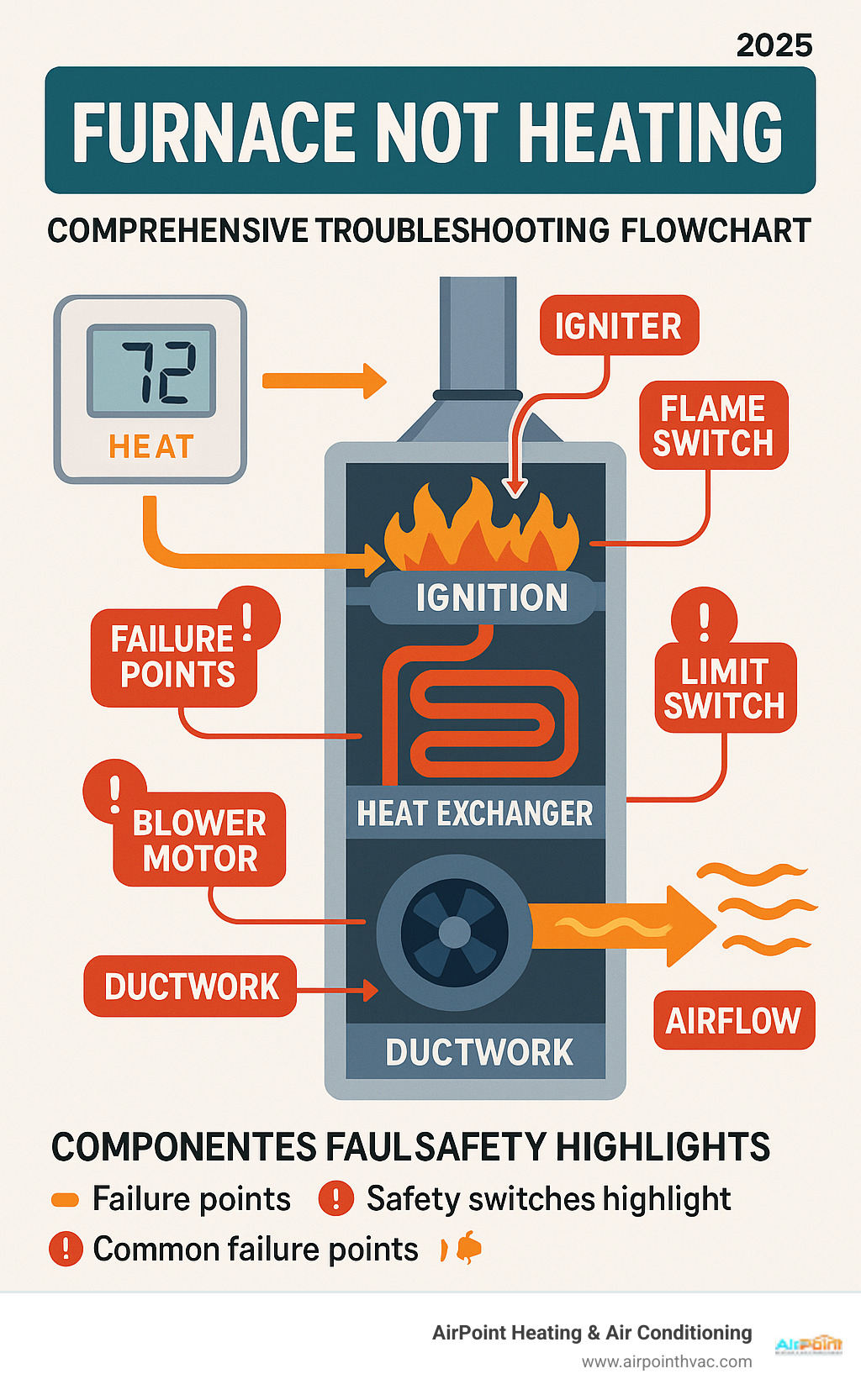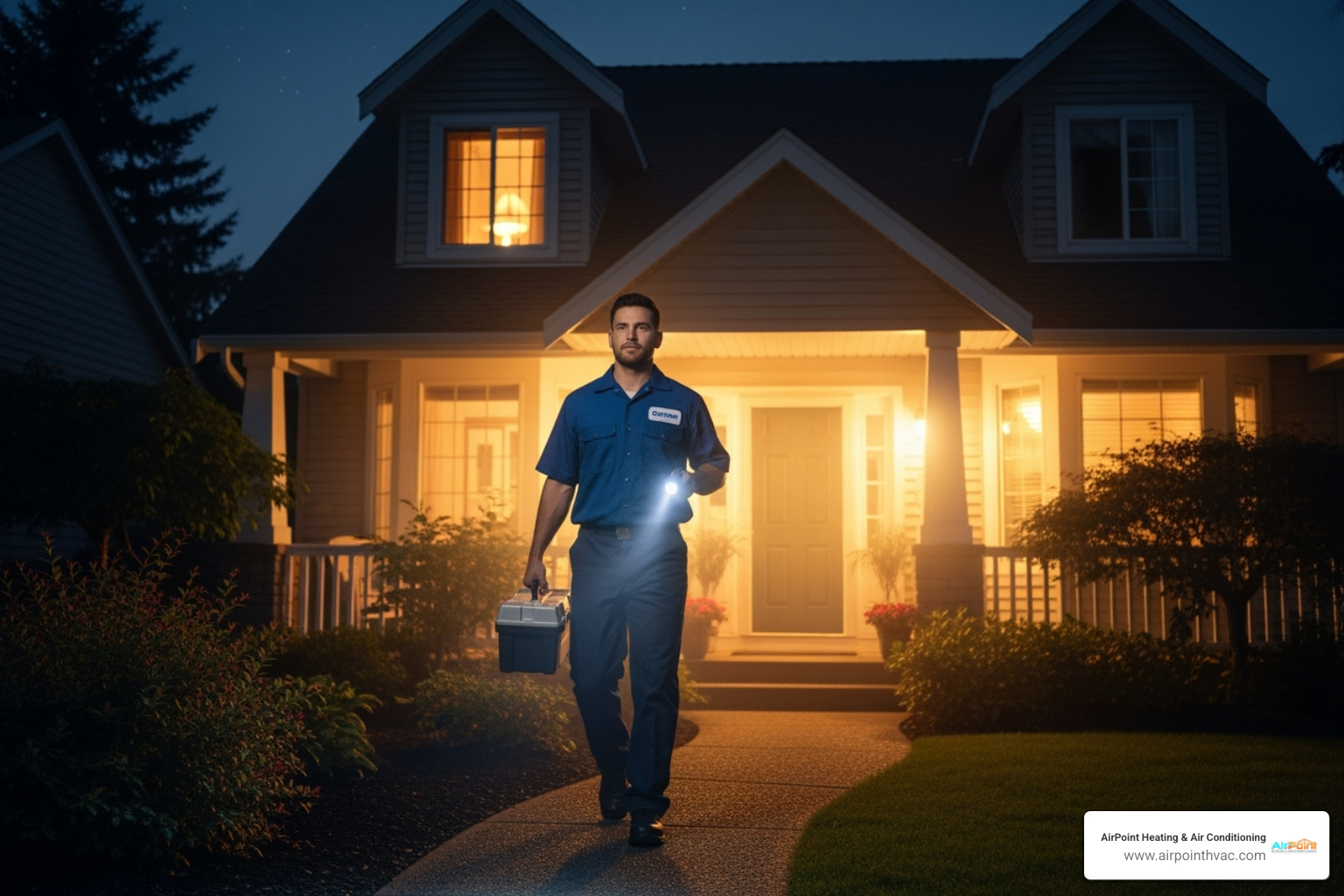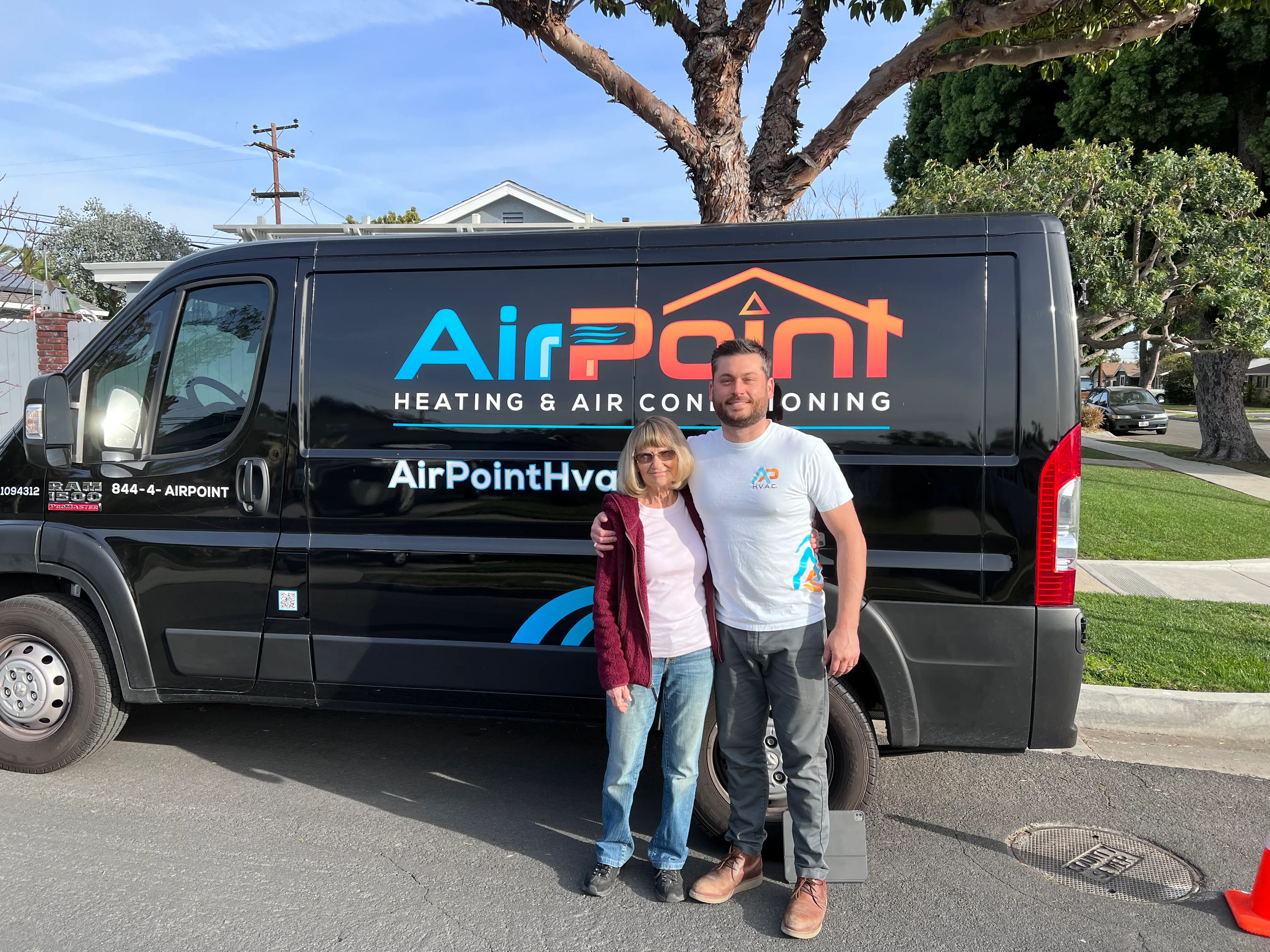
Why Your Furnace Stops Heating: Understanding the Problem
When your furnace not heating properly leaves you shivering, you need answers fast. The good news is that most heating problems have simple causes you can often identify and sometimes fix yourself.
Quick Furnace Troubleshooting Checklist:
- Check thermostat - Set to "Heat" mode, temperature 5+ degrees above room temp
- Verify power - Check circuit breakers and furnace switches
- Inspect air filter - Replace if dirty or clogged (every 30-90 days)
- Look at vents - Ensure registers are open and unobstructed
- Check pilot light - Relight if out (gas furnaces)
- Examine exhaust vents - Clear any blockages outside
It's a frustrating situation many homeowners face: you're bundled up indoors because your furnace has stopped working. Dirty filters are the most common cause of furnace problems, followed by thermostat issues, power problems, and blocked airflow. While some fixes are simple DIY tasks, others require professional attention for safety reasons.
This guide walks you through the top 10 furnace issues, starting with the easiest checks that solve problems 80% of the time, helping you know what to check first and when to call for help.

First Steps: Quick Checks for a Furnace Not Turning On
When your furnace doesn't turn on, the cause is often surprisingly simple. Before assuming a major repair is needed, perform these quick checks that solve the majority of heating problems in just a few minutes.

1. Check Your Thermostat Settings
Your thermostat controls your heating system, so incorrect settings are a common reason a furnace not heating issue occurs.
- Set to "Heat" Mode: Ensure the thermostat isn't accidentally switched to "Cool" or "Off."
- Raise the Temperature: Set the temperature at least 5 degrees higher than the current room temperature to signal the furnace to turn on.
- Check the Fan Setting: The fan should be on "Auto," not "On." The "On" setting blows air continuously, even when the furnace isn't heating, which can make it feel like only cold air is circulating.
- Replace Batteries: If your thermostat has a dim or blank display, replace the batteries. This simple maintenance is often forgotten. For more complex issues with smart thermostats, you can find more info about smart thermostats.
2. Verify Power to the Furnace
Like any major appliance, your furnace needs electricity to operate.
- Check the Circuit Breaker: Go to your electrical panel and find the breaker labeled "Furnace" or "HVAC." If it has tripped (it will be in the middle or "Off" position), reset it by pushing it firmly to "Off" and then back to "On."
- Find the Furnace Power Switch: Look for a switch, often resembling a light switch, on or near the furnace unit. Make sure it's in the "On" position, as it can be accidentally turned off.
- Inspect Safety Switches: Modern furnaces have safety switches on the access panels. If a panel is loose or not properly closed, the system won't run. Check that all panels are securely fastened.
Common Reasons Your Furnace is Not Heating and How to Fix Them
If the basic checks didn't solve the problem, the issue likely lies with airflow or ignition. These common furnace not heating problems often have straightforward solutions.

3. A Dirty or Clogged Furnace Filter
A dirty furnace filter is the single most common cause of heating problems. When the filter is clogged with dust and debris, it restricts airflow, causing several issues:
- Overheating: Lack of airflow can cause the heat exchanger to overheat, triggering a safety switch that shuts down the burners.
- Short Cycling: The furnace turns on, runs briefly, then shuts off before the home is warm.
- Higher Energy Bills: The system works harder to compensate for the blockage.
The fix is simple: check your filter monthly. If it's dirty, replace it. Most homes need a new filter every 30-90 days. Ensure the arrow on the new filter points toward the furnace. For more details, see our guide on how air filters impact your HVAC system.
4. Pilot Light or Electronic Ignition Failure
For your furnace to produce heat, it must ignite the fuel. Problems with the ignition system will prevent this.
- Pilot Light (Older Furnaces): A pilot light is a small, constant flame. If it goes out due to a draft or clogged opening, the furnace won't heat. You can relight it by following the manufacturer's instructions, which typically involve turning the gas knob to "Pilot," holding it down, and lighting the pilot opening. Wait a minute for the thermocouple to heat up before releasing the knob.
- Electronic Ignition (Newer Furnaces): Modern furnaces use a hot surface ignitor or a spark ignitor. If these components fail, the gas valve won't open. A dirty flame sensor—a small metal rod that detects the flame—can also cause ignition failure. While you can try gently cleaning the flame sensor with fine-grit sandpaper, persistent issues require a professional. Our article on Furnace Repair Common Signs covers more symptoms.
5. Blocked Vents or Exhaust Flue
Your furnace must safely vent combustion gases outside. A blockage in the exhaust flue will trigger a safety shutdown.
- External Vents: Check outdoor vents for blockages from leaves, snow, ice, or animal nests. High-efficiency furnaces with PVC vents are particularly susceptible to ice blockages in cold weather.
- Internal Vents: Ensure furniture, rugs, or other items are not blocking the heat registers inside your home. Open dampers in your ductwork to allow for proper airflow.
Deeper Diagnostics: Airflow and System-Level Problems
If basic troubleshooting fails, the furnace not heating problem may stem from deeper system issues related to airflow or drainage. Understanding these can help you identify the problem, even if you need a professional for the fix.
6. Leaky or Blocked Ductwork
Your ductwork is the delivery system for warm air. Leaks, blockages, or disconnections can prevent heat from reaching your rooms. Leaky ducts can waste up to 30% of heated air, increasing your bills.
- Signs of Duct Problems: Look for uneven heating (some rooms are warm, others cold), poor airflow from vents, or crushed flexible ducts in attics or crawl spaces.
- DIY Fixes vs. Professional Help: You can seal small, accessible gaps with metallic duct tape (not cloth-based tape). However, significant damage, disconnections, or blockages require professional repair. Our team handles HVAC Ductwork Installation Issues and can determine if distribution is the root cause. We also offer incentives like 500 Off Ductwork with a Purchase of a Full System Install.
7. Clogged Condensate Drain Line
This issue affects high-efficiency condensing furnaces, which produce water as a byproduct of heating. This water is removed via a PVC drain line. If the line clogs with algae or debris, water backs up, and a safety float switch shuts down the furnace to prevent water damage.
- Signs of a Clog: The most obvious sign is water pooling around the base of your furnace.
- How to Clear a Clog: You can often clear minor clogs yourself. Use a wet/dry vacuum to suction out the blockage from the drain line's access point. Alternatively, you can carefully pour a mixture of 1 cup distilled white vinegar and 1 cup warm water down the line to dissolve buildup.
| Feature | Standard Efficiency Furnace | High-Efficiency Condensing Furnace |
|---|---|---|
| Heat Exchanger | Primary, single-stage | Primary + Secondary, multi-stage |
| Combustion Byproduct | Hot gases | Condensed water (acidic) |
| Venting | Metal flue pipe (chimney) | PVC pipes (side wall or roof) |
| Condensate Drain | Not applicable | Essential for operation, prone to clogs |
| Drain Line Maintenance | Not applicable | Regular flushing recommended |
| Annual Checkup Focus | Burners, heat exchanger, blower, filter | All above + condensate system, PVC pipes |
When to Call a Pro vs. Time for a Replacement
If you've tried all the DIY steps and your furnace not heating problem persists, it's time to consider professional help. Some issues are too complex or dangerous for a DIY fix, and sometimes, replacement is a more cost-effective solution than another repair.

8. Signs You Need Professional Furnace Repair
Certain red flags indicate you should step back and call an expert for your safety.
- Gas Smell: If you smell rotten eggs, you may have a gas leak. Turn off the gas supply, open windows, evacuate the house, and call your gas company from a safe distance. Do not use phones or flip switches inside.
- Loud or Strange Noises: Loud banging, popping, scraping, or squealing sounds point to serious mechanical problems, such as ignition issues or a failing blower motor.
- Persistent Short Cycling: If the furnace repeatedly turns on and off without heating your home (and you've already changed the filter), it could be an oversized unit or a faulty component.
- Error Codes: Blinking lights or codes on your furnace's display usually point to specific part failures that require a technician's diagnostic tools.
- Yellow Pilot Light: A healthy pilot light is blue. A yellow or orange flame indicates incomplete combustion, which can produce dangerous carbon monoxide and requires immediate professional service.
When in doubt, prioritize safety. You can Find a certified HVAC technician through NATE to ensure they are qualified. For more warning signs, see our guide on Immediate Furnace Repair Indicators.
9. Is It Time for a Furnace Replacement?
Sometimes, replacing an old furnace is a better investment than continuing with costly repairs.
- Age: Most furnaces last 15-20 years. Beyond this point, efficiency declines and failures become more common.
- Rising Energy Bills: If your heating costs are climbing without a clear reason, your furnace is likely losing efficiency.
- Frequent Repairs: If repair costs are adding up, it may be more economical to invest in a new, reliable system.
- Uneven Heating: A furnace that can no longer heat your home evenly is struggling to perform its basic function.
- Visible Wear and Tear: Excessive rust, soot, or moisture around the unit are signs that the system is nearing the end of its life.
A new furnace offers improved reliability, better energy efficiency, and improved air quality. To help with this decision, explore our guide on When to Consider Furnace Replacement.
10. The Importance of Regular Maintenance for a furnace not heating
Preventive maintenance is the best way to avoid future furnace not heating emergencies. An annual tune-up from a certified technician offers numerous benefits:
- Prevents Breakdowns: Catches and fixes minor issues before they become major problems.
- Improves Efficiency: A clean, well-tuned furnace uses less energy, lowering your bills.
- Ensures Safety: Technicians check for gas leaks, carbon monoxide, and cracked heat exchangers.
- Extends Lifespan: Proper care helps your furnace last longer, delaying replacement costs.
- Maintains Warranty: Many manufacturers require annual service to keep your warranty valid.
Schedule your tune-up in the fall to ensure your system is ready for winter. Learn more about why Scheduling Furnace Tune-Up is Essential.
Conclusion
When your furnace not heating leaves you in the cold, it's frustrating. However, you now have a clear guide to diagnose and solve the most common issues. Start with the simple fixes: check your thermostat, verify power, and replace a dirty air filter, as these solve the majority of problems.
From there, you can investigate ignition issues, blocked vents, or clogged drain lines. While many of these can be DIY fixes, safety must always come first. If you smell gas, hear loud noises, or feel uncomfortable with a repair, call a professional immediately.
The best way to prevent a furnace not heating emergency is with regular maintenance. An annual tune-up keeps your system efficient, safe, and reliable, saving you from future headaches and costly repairs.
At AirPoint Heating & Air Conditioning, your family's comfort is our priority. As a family-owned business serving Southern California, our certified technicians have the experience to solve any furnace problem quickly and safely. We stand by our work with a 100% satisfaction guarantee.
Whether you need a repair, maintenance, or are considering a new furnace, we're here to help. Don't stay in the cold—schedule your furnace repair today and restore the warmth and comfort to your home.
Other Blogs
Latest Blog Posts

Don't Freeze! Get 24-Hour Heating Service in Fountain Valley, CA

Don't Freeze! Get 24/7 Heating Help in Brea

Emergency Heat: Your Guide to 24/7 HVAC in Mission Viejo
Customer Testimonials










